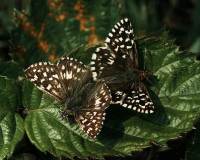 |
 |
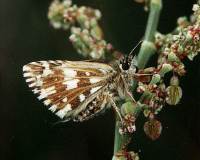 |
|
| Grizzled Skipper Pyrgus malvae © photo: Alan Downie |
In 2007 the Grizzled Skipper became a UK Priority Species. It is also Hertfordshire BAP Plan Species. The Grizzled Skipper had been identified in the Thames Regional Action Plan as having Medium Priority status but new knowledge of its distribution and rates of decline thanks to the Millennium Atlas demonstrated why species should be given such urgent higher priority.
A copy of the Species Action Plan can be downloaded here.
Details of the Eastern Region Grizzled Skipper Awareness Campaign here
Grizzled Skippers are small lively moth-like butterflies, which fly in early spring and dart about busily in warm sunshine, almost disappearing as their wings blur against surrounding flowers and grasses. Sometimes the males soar skywards to court females or chase off rivals. When they perch on prominent twigs, bask with wings open and backs to the sun or take nectar from Bugle or Forget-me-not their distinctive black and white chequerboard wing pattern makes them readily identifiable. In dull weather or at night they rest, often communally, on grass or flowerheads. Although well-camouflaged and hard to spot, for a sharp-eyed naturalist this is a good time to observe and count them
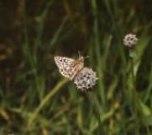 |
 |
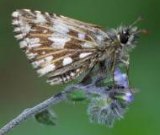 |
 |
| © photo: Chris Pickford | © photo: John Stevens | © photo: John Stevens | © photo: Liz Goodyear |
Grizzled Skippers in roosting or semi-roosting position - note the size in relation to the flower heads in particular the forget me knot
This species is usually single-brooded and adults may appear from late April. By mid-June the flight season has finished and the next generation of eggs have been laid singly on the underside of leaves of foodplants, such as Wild Strawberry, Common Agrimony, Tormentil and Creeping Cinquefoil. The females choose plants growing in warm situations next to bare ground or low-growing vegetation. The tiny yellow caterpillar emerges after about 10 days. It spins a protective tent along the midrib of its leaf, venturing out only to feed or build a new, larger tent. It nibbles the leaf around the edges of its shelter leaving characteristic blotches that are easy to spot. As the caterpillars grow they move to more nutrient-rich taller plants, such as Bramble. They overwinter as pupae inside cocoons of leaves and silk amongst low-growing vegetation. The adult butterflies normally live in small colonies of about 100. Most adults stay within the colony, but some fly up to 1.5km and may be able to fly much further.
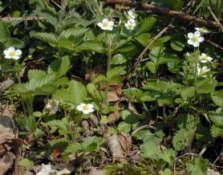 |
 |
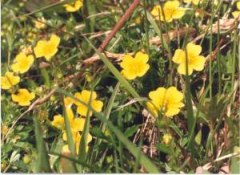 |
fragaria vesca © photo: Malcolm Storey BioImages - Virtual Field-Guide (UK) |
fragaria vesca © photo: Malcolm Storey BioImages - Virtual Field-Guide (UK) |
potentlla erecta © photo: C.Shepperson |
Grizzled Skippers flourish in
habitats characterised by sunny, sheltered conditions. They need a
plentiful supply of spring nectar plants for feeding, an abundance of
larval foodplants for breeding and patches of ranker vegetation for
perching and roosting. They occupy 3 main habitat types; woodland
clearings* (in Hertfordshire this was typified by the colony
that used to be found in the glades at Broxbourne Woods)
unimproved, often chalky, and usually scrubby
grassland (the colony at Aldbury Nowers is located in this type
of habitat) and recently abandoned artificial habitats
such as gravel pits and railway lines (e.g. the colonies at the disused
gravel workings at Waterford Heath).
This butterfly is near the north of its range in Britain. Its strongholds are in the southern English counties, although it also occurs in central England and Wales. It is generally very local and is declining throughout its British range, especially in flat heavily farmed areas. This decline has been especially steep since the 1950s with habitat loss and long cold springs as important contributory factors.
* There are now no known woodland colonies in Hertfordshire
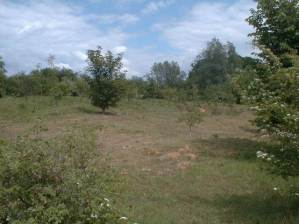 |
 |
© photo: Andrew Wood |
© photo: Andrew Wood |
 |
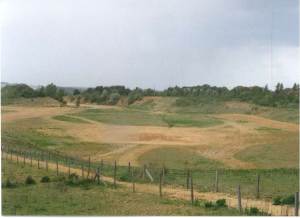 |
© photo: Christine Shepperson |
© photo: Christine Shepperson |
The butterfly is believed to be extinct in Middlesex, but is still known in Hertfordshire. When Brian Sawford published The Butterflies of Hertfordshire in 1987, Grizzled Skippers had been recorded in 38 of the 450 or so 2km x 2km squares (tetrads) in Hertfordshire since 1970. By 1995 there were no confirmed sightings at all in Hertfordshire. Fortunately it was found again in 1996 and during a countywide survey from 1998 - 2000 by a team of voluntary recorders co-ordinated by Christine Shepperson from the Herts and Middx Branch of Butterfly Conservation records were confirmed at some traditional sites and two new ones. Between 1996 and 2000 Grizzled Skippers were found, normally in fairly small colonies, in 17 tetrads in the County. It was now clear that this little butterfly, although vulnerable, was still hanging on in Hertfordshire, although at several of its sites it depends on conservation management for habitat maintenance.
In 2005, a second survey was conducted by Andrew Middleton and Liz Goodyear during the winter. Many of the historic sites were revisited and habitat assessments made to determine whether these sites could still support Grizzled Skipper. Two areas stood out as having potential and these were later found to support colonies of Grizzled Skipper. Many sites were no longer felt suitable.
| Site/habitat | Tetrad | Last record |
| Aldbury Nowers | SP91L | 2010 |
| Tring Park | SP91F | 200? |
| Telegraph Hill | TL12E | 2004 |
| Waterford Heath (North and South Pits) | TL31C | 2010 |
| Flight Dates | Year |
| 23 April - 22 June | 2010 |
| 19 April - 13 June | 2009 |
| 03 May - 10 June | 2008 |
| 19 April - 22 May | 2007 |
| 02 May - 24 June | 2006 |
| 30 April - 22 June | 2005 |
| 09 May - 10 June | 2004 |
| 22 April - 15 June | 2003 |
| ?? May - 1 June | 2002 |
| 20 May - 25 June | 2001 |
| 07 May - 16 June | 2000 |
| 02 May - 15 June | 1999 |
| 14 May - 19 June | 1998 |
| 13 April - 8 June | 1997 |
| 27 April - 15 June | 1996 |
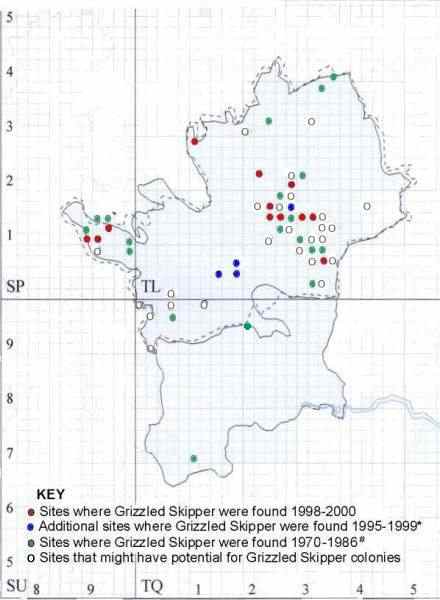
| SYMBOL | DATE | REFERENCE SOURCE |
 |
1998-2004 | Indicates records sent to Christine Shepperson or Jez Perkins |
 |
1995-2001 | Additional sites where Grizzled Skipper were found 1995-1999 taken from the Herts & Middx Butterfly Report for 1999 - John B. Murray & Rob Souter |
 |
1970-1987 | Indicates records taken from Butterflies of Hertfordshire - Brian Sawford 1987 or The Butterflies of the London Area - Colin Plant 1987 |
| Indicates sites that were thought might have potential for Grizzled Skipper colonies |
Much of the original text on this page was published in Wildlife Matters, the newsletter of the Herts & Middx Wildlife Trust and the author thanks the Trust for permission to use the material on this website.
Christine Shepperson
March 2002
(However much has changed since the article was written, new sites have been found but others have been lost. The text has been edited to reflect this ~ March 2010)